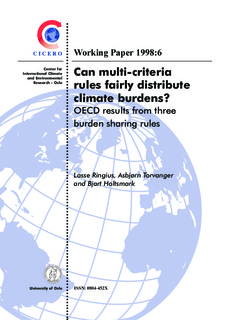Can multi-criteria rules fairly distribute climate burdens? OECD results from three burden-sharing rules
| dc.contributor.author | Ringius, Lasse | nb_NO |
| dc.contributor.author | Torvanger, Asbjørn | nb_NO |
| dc.contributor.author | Holtsmark, Bjart | nb_NO |
| dc.date.accessioned | 2014-03-17T14:31:00Z | |
| dc.date.available | 2014-03-17T14:31:00Z | |
| dc.date.issued | 1998 | nb_NO |
| dc.identifier.issn | 0504-452X | nb_NO |
| dc.identifier.uri | http://hdl.handle.net/11250/192138 | |
| dc.description.abstract | An important feature of the Protocol concluded in Kyoto, Japan, in December 1997 is the differentiation of the climate targets of the industrialized countries. A more systematic approach to burden sharing than that leading to the Kyoto Protocol could help negotiating targets after 2012, and when including developing countries in the group of countries with climate targets at a later stage. The article discusses a number of concepts of equity, examines three specific burden sharing rules and formulae, and presents cost calculations on the burden sharing rules. The three formulae that are explored have some ability to adapt to national circumstances, but none of them creates a burden sharing arrangement that completely equalizes the national income losses as percentage of GDP across the OECD. Nonetheless, the results show that burden sharing rules can be useful tools and provide some, but not all, of the guiding framework for climate policy negotiations. | nb_NO |
| dc.language.iso | eng | nb_NO |
| dc.publisher | CICERO Center for International Climate and Environmental Research - Oslo | nb_NO |
| dc.relation.ispartof | CICERO Working Paper | nb_NO |
| dc.relation.ispartofseries | CICERO Working Paper;1998:06 | nb_NO |
| dc.title | Can multi-criteria rules fairly distribute climate burdens? OECD results from three burden-sharing rules | nb_NO |
| dc.type | Working paper | nb_NO |
| dc.source.pagenumber | nb_NO | |
| dc.identifier.cristin | 1728033 |
Tilhørende fil(er)
Denne innførselen finnes i følgende samling(er)
-
CICERO Working Papers [167]
Working Papers published by CICERO
